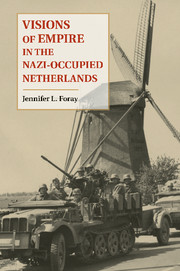Book contents
- Frontmatter
- Contents
- Acknowledgments
- Abbreviations
- Introduction
- 1 War Comes to the Kingdom
- 2 The Landscape of Resistance and the Clandestine Press
- 3 “Look to the East!”
- 4 “Indies Lost, Disaster Born”
- 5 Mutuality, Equality, and the Commonwealth
- 6 Countering the Commonwealth
- 7 “After Our Liberation, That of Indonesia”
- 8 Wartime Consensus and Postwar Pressures
- Conclusion
- Bibliography
- Index
- References
7 - “After Our Liberation, That of Indonesia”
Preparing for Battle
Published online by Cambridge University Press: 05 December 2011
- Frontmatter
- Contents
- Acknowledgments
- Abbreviations
- Introduction
- 1 War Comes to the Kingdom
- 2 The Landscape of Resistance and the Clandestine Press
- 3 “Look to the East!”
- 4 “Indies Lost, Disaster Born”
- 5 Mutuality, Equality, and the Commonwealth
- 6 Countering the Commonwealth
- 7 “After Our Liberation, That of Indonesia”
- 8 Wartime Consensus and Postwar Pressures
- Conclusion
- Bibliography
- Index
- References
Summary
Even before Allied forces arrived in the Netherlands, the Dutch people could sense the beginning of the end was near. On September 5, 1944, a day later known as “Mad Tuesday,” jubilant crowds flooded the country’s streets to greet the liberators they falsely believed were entering the country, while thousands of Dutch Nazis and their families fled eastward in order to avoid a much-feared “day of reckoning.” Less than two weeks later, the Allies landed in the cities of Arnhem and Nijmegen, and the government-in-exile, hoping to prevent the transport of German reinforcements to the region, ordered Dutch railway workers to go on strike. Operation Market Garden was under way. During the month of September, the Allies did in fact liberate a number of southern Dutch cities, such as Maastricht and Eindhoven, and by early November they had liberated roughly the southern third of the country. However, by mid-September, the Allied advance through the Netherlands ground to a halt, and the populous north and northwest regions of the country were subjected to eight more months of German rule under rapidly deteriorating conditions. The country’s 30,000 railway workers, who continued their strike even after the failure of Market Garden, needed to go into hiding to escape arrest. They would join 300,000 others already living underground – Jews, students, former Dutch soldiers, young men looking to escape the ever-expanding labor draft.
In response to both the initial strike and the railway men’s refusal to return to work, Reichskommissar Seyss-Inquart instituted a six-week embargo of foodstuffs and coal supplies to the occupied northwestern sector of the country. This action, coupled with the unseasonably cold weather, would set in motion the notorious “Hunger Winter” of 1944 and 1945, resulting in approximately 16,000 deaths during this final winter of the war. Earlier this year, Seyss-Inquart had declared martial law and made any disturbance of public order – whether major or minor – punishable by death. Now, with the Allies closing in, he granted both Hanns Rauter, the Commissioner General for Police and Security Affairs (HSSpF), and Wehrmachtsbefehlshaber Christiansen, the Commander of the Armed Forces in the Netherlands, the authority to exercise summary justice against those accused of resistance activity. Suspected resisters were not the only Dutch citizens to incur such punishment, for thousands of innocent people – often in the wrong place at the wrong time – were either shot in reprisal actions or deported to Germany for forced labor. If, before this point, only certain segments of the population had been subjected to persecution and substandard living conditions, now nearly everyone living in the occupied areas felt the effects of war and occupation.
- Type
- Chapter
- Information
- Visions of Empire in the Nazi-Occupied Netherlands , pp. 218 - 252Publisher: Cambridge University PressPrint publication year: 2011



